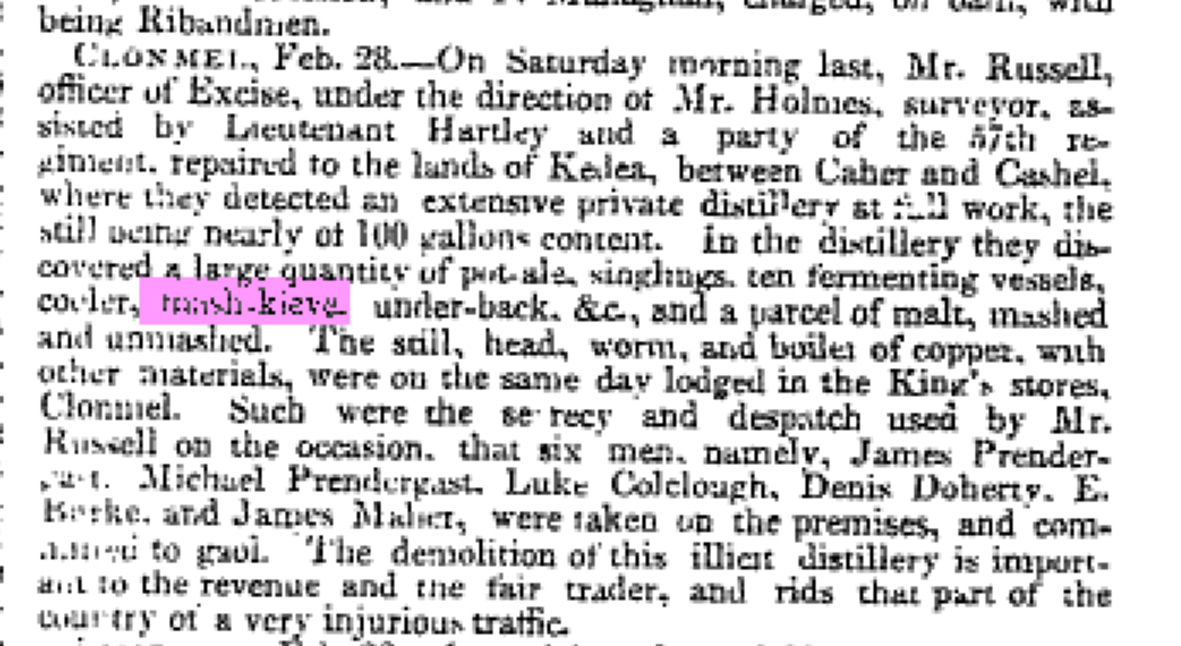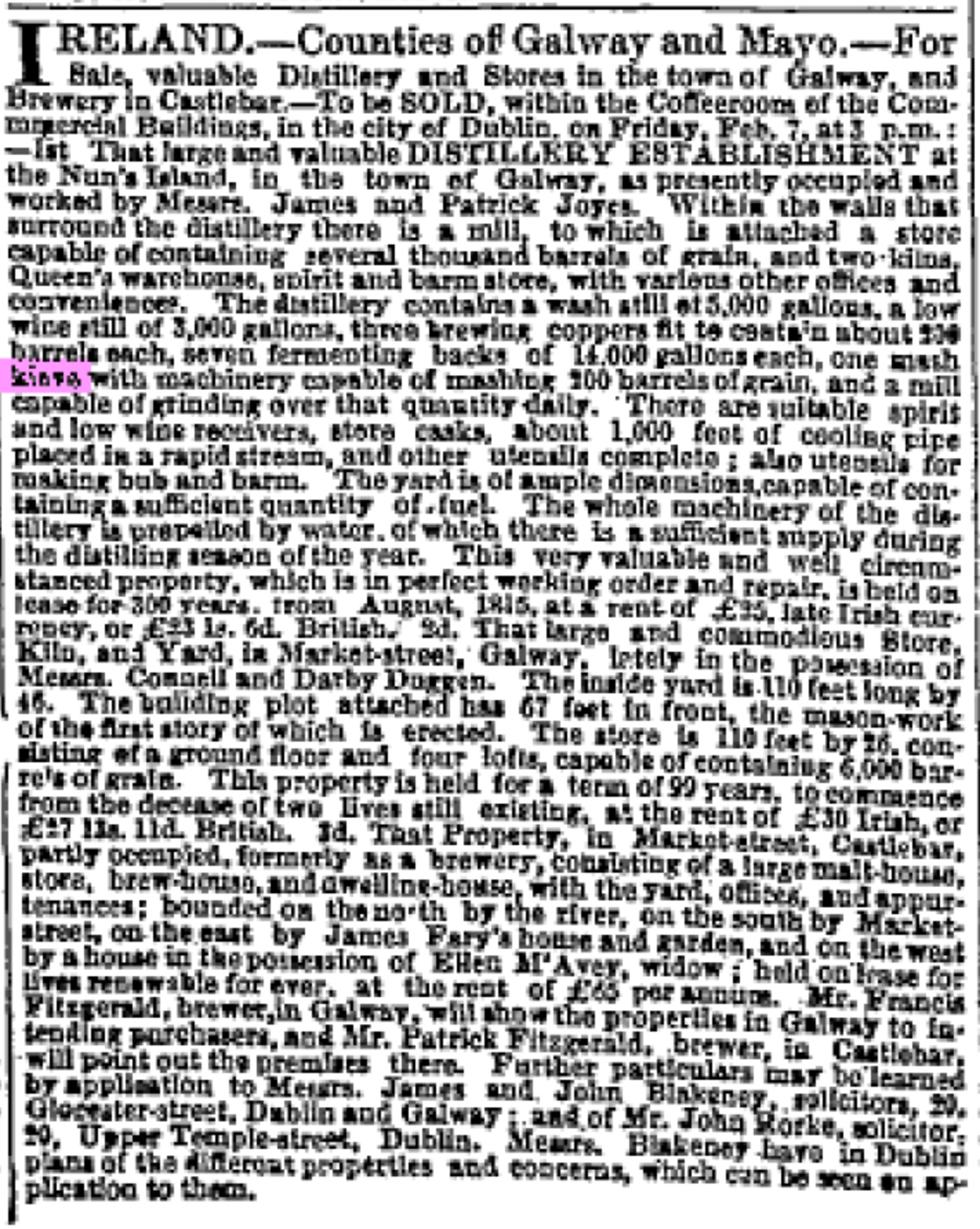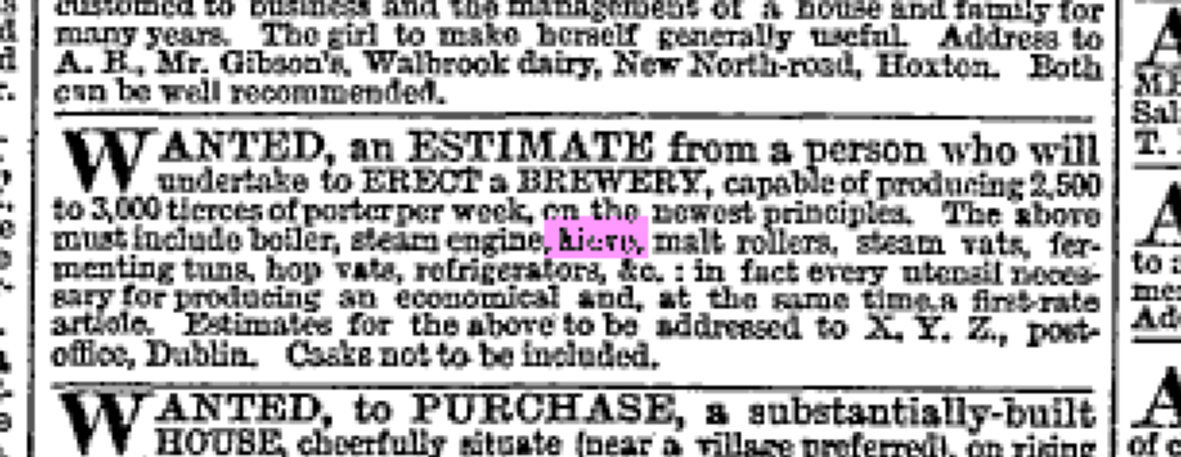Sound like a trio of Victorian lawyers, don’t they? Kieve, Tierce and Bubb, solicitors and commissioners of oaths: I can picture their brass plate, polished and worn, at the top of a set of stone steps, screwed to the slightly crumbly brickwork of a flat-fronted three-storey town house with a shiny black-painted front door, somewhere near Carey Street.
They’re actually, however, not minor characters from Bleak House but three obscure words linked to brewing, the first and least obscure being an old term for a mash tun, which I mentioned in my last posting about a 13th century Norman French poem describing the brewing of ale. I said kieve was “still used in Ireland”, leading Beer Nut, one of Ireland’s finest beer bloggers (you can pay me later, John), to ask: “Is ‘kieve’ used for mash tun outside of St James’s Gate? I’ve never heard it in the context of any other Irish brewery.”
I was originally going to write a short reply to Beer Nut’s comment saying yes, indeed, other people than Guinness used the term “kieve”, but the interwebs is an increasingly marvellous resource for historians as more and more information from the past becomes digitised, and very quickly, as I chased after extra facts on kieves, I was distracted by bub, and then off in pursuit of tierce.
Kieve first: the word can refer to any sort of tub or vat, and is found in the bleaching, cider-making and mining industries (tin and copper ores are, or were, washed in vessels called kieves). It was certainly a term used by English brewers: the Oxford English Dictionary (which suggests the word may be linked to the German kübel, bucket) quotes from the second edition of William Ellis’s London and Country Brewer, published in 1743, in which he says: “In Winter they ferment a little first in the Kive or Tun to put to the Wort in the Barrel.” An advertisment for the sale of an inn called the Kings Arms in Hampshire in The Times in September 1813 includes a brewhouse with 100-gallon copper, “mash tun and kieve tubs”.
However, 19th century references in the archives of The Times (my library card gives me free access over the net to the digitised version – almost makes my appallingly high council tax bill seem worth paying) to kieves seem to be almost entirely Irish-based (there’s one to a tin mine in Cornwall), though not just linked to Guinness, and not just linked to brewing either: Irish whiskey distillers also called their mash tuns kieves. A fascinating report from February 1820 reports a raid by excisemen and soldiers on an illegal distillery operating near Clonmel, with the kit seized including “ten fermenting vessels, cooler, mash-kieve, underback etc.”
In January 1840 The Times printed a sale advertisement for a distillery at Nun’s Island in Galway town, run by James and Patrick Joyce, in which the equipment included stills, three brewing coppers, seven fermenting backs and one “mash kieve” capable of mashing 200 barrels of grain (it was the Irish tradition to measure malt and grain by the barrel, rather than the bushel and the quarter, as done in England). The distillery also had “utensils for making bub and barm”.
 Barm, of course, is yeast, as in barm cakes, but bub? I had recollections of seeing the word used as a cant term for strong drink by 17th and 18th century writers: that did not seem to fit the circumstances here. The Oxford English Dictionary (full version also available on the net via my library card, another win for the council tax) supplied the answer:
Barm, of course, is yeast, as in barm cakes, but bub? I had recollections of seeing the word used as a cant term for strong drink by 17th and 18th century writers: that did not seem to fit the circumstances here. The Oxford English Dictionary (full version also available on the net via my library card, another win for the council tax) supplied the answer:
“Bub – 1. A slang word for drink, esp. strong beer. 2. A mixture of meal and yeast with warm wort and water, used to promote fermentation.”
So there we are: if your fermentation is sluggish or sticking, bung in some bub, bud. (I’ve reproduced this ad, especially for BN, as it also contains a reference to the sale of a former brewery in Castlebar, Mayo.)
In April 1856 The Times ran a small ad that said: “Wanted, an estimate from a person who will undertake to erect a brewery, capable of producing 2,500 to 3,000 tierces of porter per week on the newest principles. The above must include boiler, steam engine, kieve, malt rollers, steam vats, fermenting tuns, hop vats, refrigerators etc … Estimates for the above to be addressed to X.Y.Z,, post-office, Dublin.”

I was going to bet that this was inserted by Alexander Findlater, a Dublin wine merchant who founded the Mountjoy brewery to take on Guinness and the other Dublin porter brewers, such as D’Arcy, but the sources I have say he opened his brewery in 1852, four years earlier than the advertisement here. So which brave entrepreneur (or idiot) was looking to start yet another porter brewery in Dublin, then? Anyway, whoever it was, they called mash tuns kieves, more evidence that the word was in use outside St James’s Gate.
They also talked about tierces of porter, rather than barrels or hogsheads. Ever heard of a tierce? Nor me, or at least, I don’t remember having come across it before. The Oxford English Dictionary has, though, hurrah, and says it’s a cask equivalent in size to a third of a pipe, a pipe being 126 “wine” gallons (the “wine” gallon is the basis of the modern US gallon). The tierce (the word comes ultimately from the Latin tertium, meaning, you’ve guessed, “a third”) is therefore 42 “wine” (or US) gallons, 35 Imperial gallons, halfway between an old Irish barrel (34 gallons) and a British one (36 gallons).

Great stuff, Mr Z, thanks.
I don’t think it would have been quite as lunatic as it might seem to have opened a brewery in Dublin in 1856: this was the beginning of a boom time for Dublin porter. In 1855 Dublin turned out 90k hhds of porter; in 1868 the figure was 258k hhds. Mary E. Daly (Dublin: The Deposed Capital, 1984) says that Dublin’s smaller breweries benefitted more at this time than Guinness did, proportionally.
A big part of the attraction was doubtless the price-fixing arrangement which the brewers had cosily arranged for themselves. That didn’t start to crumble until 1868, when Manders left the cartel.
I’d say that it all looked very promising to a prospective entrepreneur in 1856. I wonder if anything came of it — the only Irish brewery I can find evidence of having started that year is James Murphy in Cork. Sadly, the Irish Times didn’t start publishing until 1859.
I had not realized barm and barmy were connected but I suppose that should have been obvious.
It’s an etymological irony that the Barmy Army are frequently full of beer.
The online OED in the US is an annual subscription of $295. If it were cheaper perhaps Americans would speak a more proper form of English.
Not if they spent their days looking up 13th century brewing terminology they wouldn’t.
Wouldn’t that be great? Communicating across the Atlantic in 13thC brewer speak.
What an interesting post. I used to work in James’s Gate where the mash tuns are still labeled kieves. I asked one of the guys who works there who is an amateur historian who knows lots about the history of Guinness about the origin of kieve. He didn’t know why they are called that.
I’ve seen reference to a colonial American drink called sillibub. Sounds rotten.
“and ‘sillibub,’ which was a mixture of warm milk and beer.”
http://strngbrew.blogspot.com/2009/06/beer-in-colonial-america-odd-mixtures.html
In British English that’s sillabub or syllabub, about which the OED says: “A drink or dish made of milk (freq. as drawn from the cow) or cream, curdled by the admixture of wine, cider, or other acid, and often sweetened and flavoured. In common use from the 16th cent. to about the middle of the 19th cent., and revived in the 20th.” Frequently found at trendy middle-class dinner parties in the 1990s. Unfortunately for the etymology of syllabub the OED says only the dreaded “o.o.o.”, “of obscure origin”, so nobody knows if it’s connected to “bub”, strong drink.
Very interesting. Tierce sounds French (“un tiers”, one-third, clearly from the Latin root identified).
It sounds like a fashionable term from the wine trade was being used in brewing circles as well. Those solicitor firms today would speak of “tranches” of a financing, same kind of thing, sort of.
As to kieve, I know I once read that it is thought derived from “cuivre”, copper, but I don’t think this can be right. First, the term in the examples cited seems to be used for mashing or fermenting, not boiling, when wood would have been used. One thinks of a tub of wood, not metal, for example. In the ads cited, kieve is not used to describe the boiling copper but the English word is.
This source suggests the term was dialectical in numerous English counties, many of which but not all have a Celtic connection. Could the term be of Celtic origin perhaps, which might explain its endurance in Ireland?
See page 300-301:
http://books.google.ca/books?id=12oPAAAAYAAJ&pg=PA300&dq=brewing+keive#v=onepage&q=brewing%20keive&f=false
If the term is used in Gaelic to mean a waterfall basin, that would seem to link it to St Knighton’s Keive in Cornwall mentioned in the attached, and perhaps the term became better known later for its use in brewing and cider-making.
Gary
Gary
http://books.google.ca/books?id=GY49Qd-rvCoC&dq=st+knighton's+keive&printsec=frontcover&source=bl&ots=egM0RSXbdX&sig=QceVcDksxfajTIOF7nLCvSYU1vQ&hl=en&ei=a-3lSsG7OI7ONbX0yZ8D&sa=X&oi=book_result&ct=result&resnum=1&ved=0CAwQ6AEwAA#v=onepage&q=keive&f=false
See at page 265, the author of this antique tale seems to be saying the term is from the Cornish language. I would think then that keive means basin in different Celtic tongues.
Gary
Oh my gosh, sorry for all the posts, but I was just reading (I am going backwards) your fascinating article on Anglo-French brewing and saw the term “cuwe” with your footnote.
This twigged me to “cuve” in modern French which means the same thing, basin or tub. Thus, the term I would think is Latinate but perhaps also Celtic. I am no language expert, but I once read that many terms in Celtic, Latin and other Western languages are similar and go back to a Sanskrit original.
Where does this leave the French cuivre meaning copper (the metal), is it related somehow to keive and cuwe and cuve? I don’t know.
Gary
Gary
So while we’re on obscure brewing terms Mr. Zythophile, can you tell me what a set of callomers is? I found this ad http://i603.photobucket.com/albums/tt113/RichieH_photo/HoeysDublinMercuryDublinIrelandThur.png while looking for info about an old local brewery, and apparently the guy has as good a set of callomers as any (without exception) in the kingdom! (although it is a little small to read, I’m sure it says ‘callomers’). Any ideas?
I’d be pretty confident that what looks like a double-l is actually a ligatured tall-s-and-t which has been broken by butting against the descender from the letter p in the line above, while what looks like a broken letter a is really a u, making the word “customers” … “set of customers” sounds odd, but looks to make sense in context.
yeah it does sound odd, I can’t imagine anyone claiming that the people of balrothery are as good a set of customers as any in the kingdom (without exception!). pretty disappointing, I was hoping I had rediscovered some arcane implement or device!